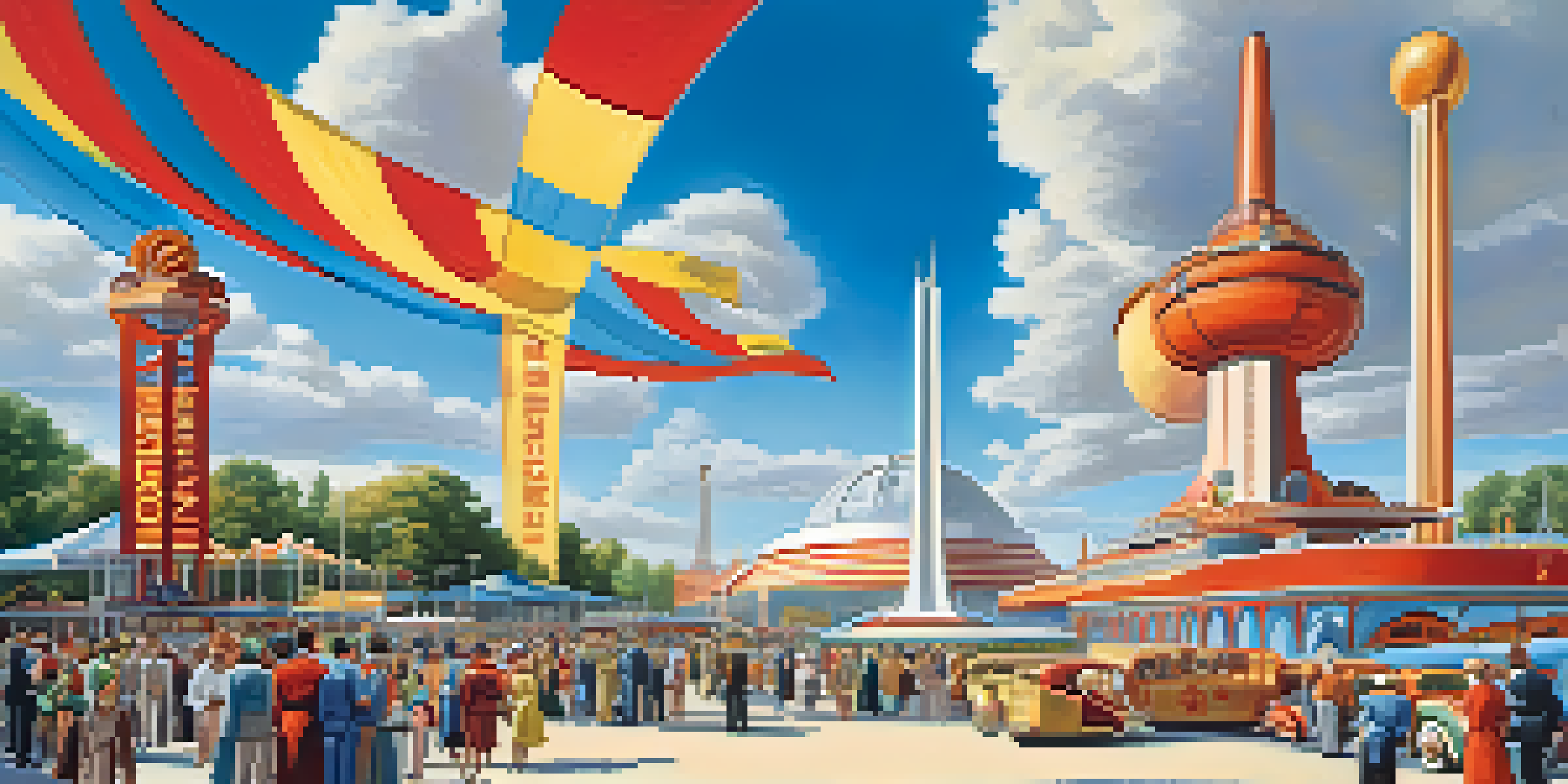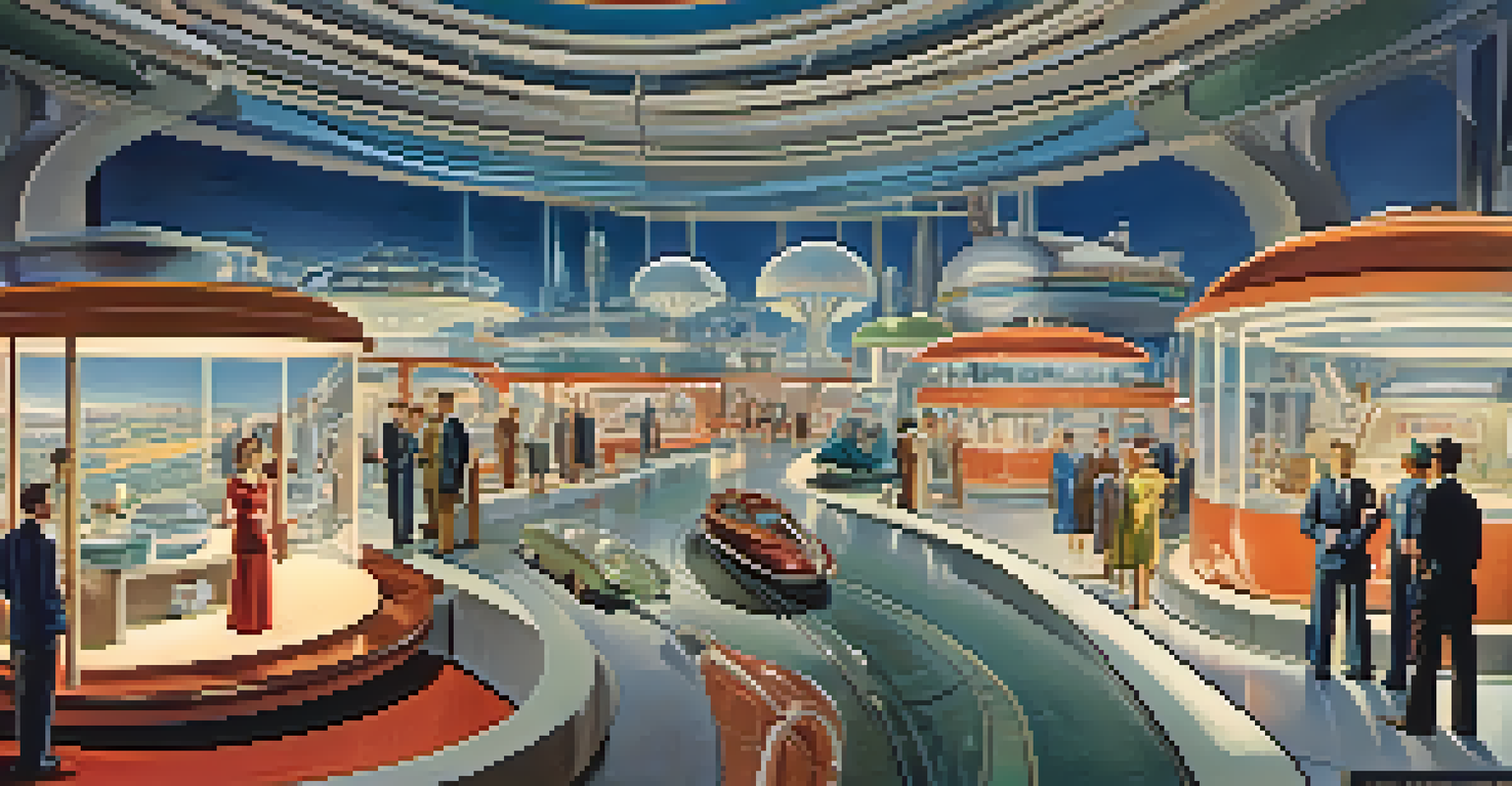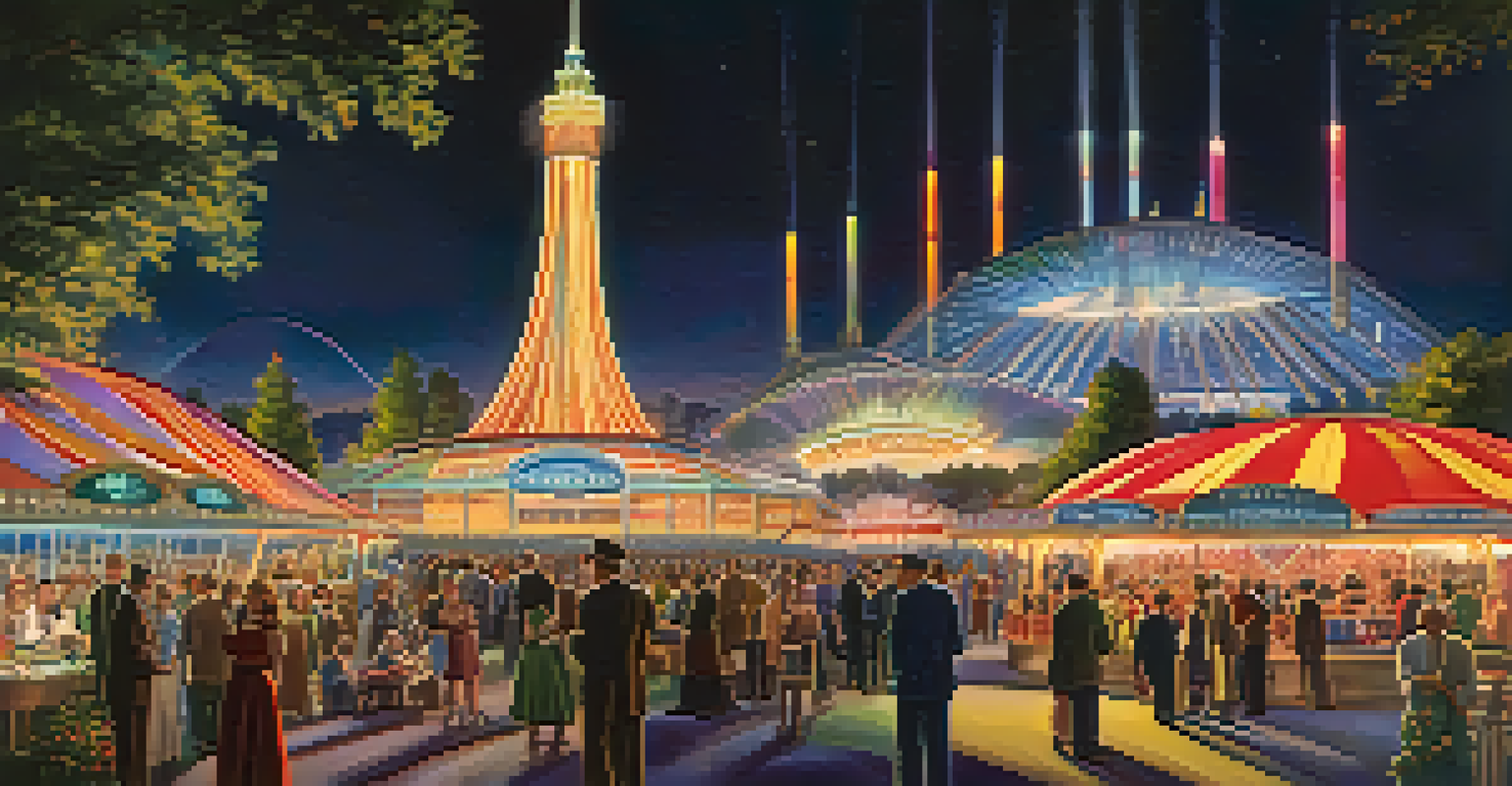The 1939 World’s Fair: Innovations and Aspirations in NYC

Overview of the 1939 World’s Fair in New York City
The 1939 World’s Fair, hosted in New York City, was a monumental event designed to showcase the future. Set against the backdrop of the Great Depression, it aimed to lift spirits and promote hope through innovation and progress. With the theme 'The World of Tomorrow,' the fair attracted millions of visitors eager to see what advancements lay ahead.
The future belongs to those who believe in the beauty of their dreams.
Spanning over two years, from April to October, the fair featured over 80 nations and numerous exhibits that highlighted technological advancements. The expansive grounds were a vibrant tapestry of architecture, art, and ideas, reflecting the optimism of a nation poised for recovery. It was a place where dreams of tomorrow were not just imagined but also displayed.
The fair not only served as a platform for showcasing new technologies but also as a cultural melting pot. Visitors were treated to a unique blend of international flair, entertainment, and the promise of a better future. This event set a precedent for future world fairs, which would continue to explore the intersection of technology and humanity.
Key Innovations Presented at the Fair
One of the standout attractions at the 1939 World’s Fair was the Futurama exhibit, designed by General Motors. This immersive experience showcased a model of a utopian city powered by technology and efficient transportation systems. Visitors were captivated by the vision of streamlined highways and automated homes, illustrating the potential of American ingenuity.

Another groundbreaking innovation was the introduction of television as a mainstream medium, with RCA demonstrating live broadcasts. Attendees were amazed by the vivid images and sounds, marking a significant leap in communication technology. The fair allowed people to witness the dawn of a new era in entertainment and information sharing.
Showcasing Innovation and Hope
The 1939 World’s Fair highlighted technological advancements and cultural exchange, fostering optimism during the Great Depression.
Additionally, the fair showcased various household appliances that promised to revolutionize daily life. From electric refrigerators to washing machines, these innovations aimed to ease household chores and enhance comfort. This focus on convenience reflected society's growing reliance on technology to improve quality of life.
Cultural Impact of the 1939 World’s Fair
The cultural impact of the 1939 World’s Fair extended far beyond its immediate innovations. It served as a catalyst for American optimism and unity during a challenging era. The fair's message of progress resonated deeply with a public weary from economic hardship, fostering a sense of hope for the future.
Innovation distinguishes between a leader and a follower.
Art and architecture were also prominently featured, with the stunning Trylon and Perisphere becoming iconic symbols of the fair. These structures embodied the fair's theme and inspired countless artists and architects. The event ultimately influenced the design of public spaces and buildings in years to come.
Moreover, the fair played a key role in promoting international goodwill and understanding. It provided a platform for nations to showcase their cultures and innovations, fostering dialogue during a time of rising global tensions. This spirit of cooperation and exchange was especially important as the world was on the brink of another conflict.
The Role of Technology in Shaping the Fair
Technology was not just a theme; it was the lifeblood of the 1939 World’s Fair. From the elaborate displays to the very layout of the fairgrounds, technology shaped every aspect of the visitor experience. This emphasis on innovation reflected a society eager to embrace the possibilities that technology promised.
The use of electric lighting transformed the fair into a dazzling spectacle at night, with millions of lights illuminating the grounds. This created an enchanting atmosphere, drawing even larger crowds during evening hours. The fair became a symbol of modernity, showcasing how technology could enhance everyday life.
Cultural Impact and Unity
The fair served as a catalyst for American unity and global goodwill, promoting dialogue and understanding among nations.
Furthermore, the fair featured futuristic concepts like the idea of a 'City of Tomorrow' which influenced urban planning and architectural design. Ideas presented at the fair sparked conversations about how cities could evolve with technology, paving the way for smart city initiatives. This vision of a technologically advanced future continues to inspire urban development today.
Art and Entertainment at the Fair
Art and entertainment were integral to the 1939 World’s Fair, enriching the visitor experience and showcasing cultural achievements. Numerous performances, exhibits, and artworks were on display, captivating audiences and celebrating creativity. The fair provided a platform for artists to experiment and reach wider audiences.
Notably, the fair featured performances by famous musicians and dancers, making it a cultural hotspot. These performances drew large crowds, offering a taste of the arts alongside the innovations. The fusion of technology and culture illustrated the fair's commitment to a holistic vision of progress.
Additionally, artworks created specifically for the event reflected the optimism and forward-thinking spirit of the time. This blending of art and innovation was crucial in communicating the fair's message, emphasizing that the future was not only about technology but also about human creativity and expression.
Legacy of the 1939 World’s Fair
The legacy of the 1939 World’s Fair is felt to this day, as it left an indelible mark on American culture and technological advancement. Many of the innovations showcased became integral parts of everyday life, influencing countless industries. The fair's vision of the future continues to resonate, inspiring new generations to dream big.
In addition to its technological impact, the fair also highlighted the importance of global cooperation and cultural exchange. The relationships built during the event contributed to post-war efforts towards peace and understanding between nations. This spirit of collaboration remains essential in tackling today's global challenges.
Legacy of Progress and Imagination
The innovations and ideas from the fair continue to inspire modern advancements and emphasize the importance of creativity in shaping the future.
Lastly, the fair's innovative spirit can be seen in modern world expos and fairs, which continue to explore themes of progress and sustainability. The lessons learned from the 1939 event encourage us to embrace change and strive for a better future, reminding us that innovation is a journey, not a destination.
Conclusion: Reflecting on the Aspirations of 1939
Reflecting on the aspirations of 1939 reveals a time of hope and creativity amidst uncertainty. The World’s Fair was more than just an exhibition; it was a celebration of human potential and the belief in a brighter future. This event captured the essence of an era that sought to redefine what was possible.
As we look back, it’s clear that the innovations and ideas presented at the fair have shaped our world in profound ways. From advances in technology to the importance of cultural exchange, the fair laid the groundwork for progress. It serves as a reminder of the power of imagination and the enduring quest for improvement.

Ultimately, the 1939 World’s Fair stands as a testament to resilience and optimism. Its legacy encourages us to continue dreaming, innovating, and striving for a world where technology and humanity coexist harmoniously. The aspirations of that era remind us that the future is ours to create.